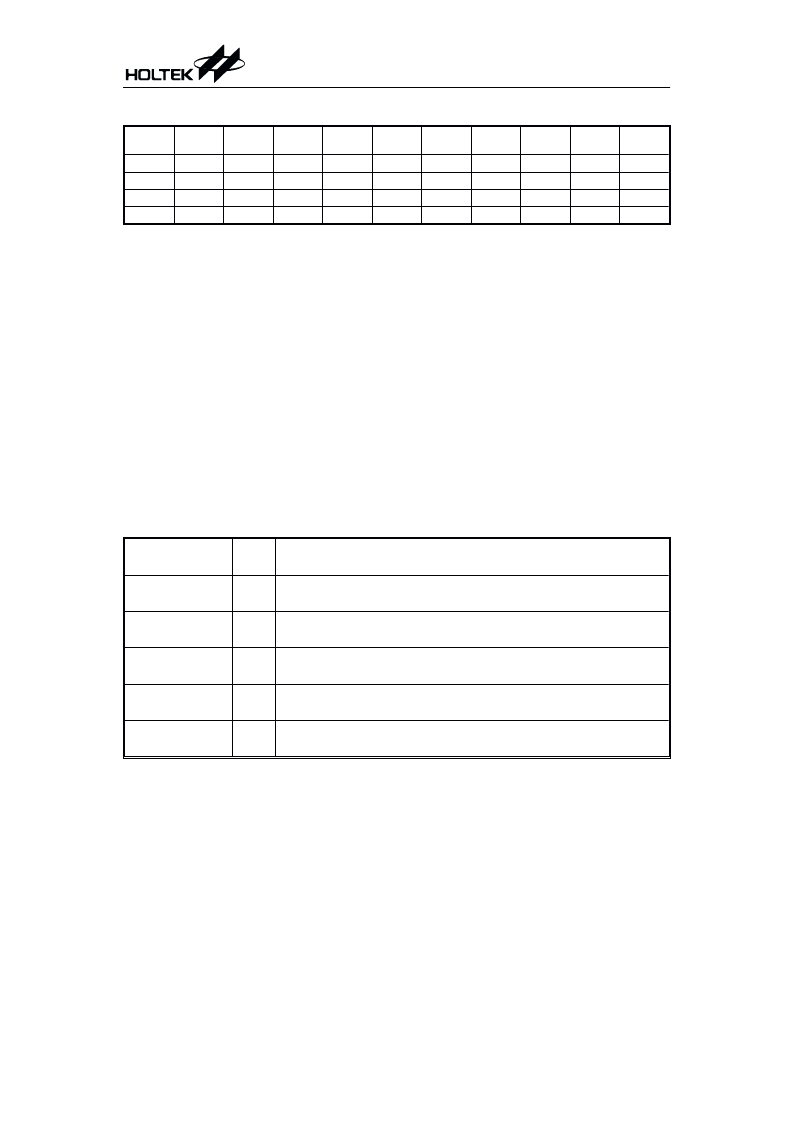- 您現(xiàn)在的位置:買賣IC網(wǎng) > PDF目錄385407 > HT9580 (Holtek Semiconductor Inc.) Character Pager Controller PDF資料下載
參數(shù)資料
| 型號: | HT9580 |
| 廠商: | Holtek Semiconductor Inc. |
| 英文描述: | Character Pager Controller |
| 中文描述: | 字符傳呼機控制器 |
| 文件頁數(shù): | 17/63頁 |
| 文件大小: | 444K |
| 代理商: | HT9580 |
第1頁第2頁第3頁第4頁第5頁第6頁第7頁第8頁第9頁第10頁第11頁第12頁第13頁第14頁第15頁第16頁當(dāng)前第17頁第18頁第19頁第20頁第21頁第22頁第23頁第24頁第25頁第26頁第27頁第28頁第29頁第30頁第31頁第32頁第33頁第34頁第35頁第36頁第37頁第38頁第39頁第40頁第41頁第42頁第43頁第44頁第45頁第46頁第47頁第48頁第49頁第50頁第51頁第52頁第53頁第54頁第55頁第56頁第57頁第58頁第59頁第60頁第61頁第62頁第63頁

HT9580
17
April 28, 2000
Preliminary
Timer registers
Address
Register
Name
Bit 7
Bit 6
Bit 5
Bit 4
Bit 3
Bit 2
Bit 1
Bit 0
State on
POR
0007H
TMRC
TMR1MOD
X
TMR1CLK
TMR0CLK
TMR1EDG
TMR0EDG
TMR1EN
TMR0EN
0u00 0000
0008H
TMR1L
TM1D7
TM1D6
TM1D5
TM1D4
TM1D3
TM1D2
TM1D1
TM1D0
uuuu uuuu
0009H
TMR1H
TM1D15
TM1D14
TM1D13
TM1D12
TM1D11
TM1D10
TM1D9
TM1D8
uuuu uuuu
000AH
TMR0
TM0D7
TM0D6
TM0D5
TM0D4
TM0D3
TM0D2
TM0D1
TM0D0
uuuu uuuu
In addition to the watchdog timer, the HT9580
provides two timers: an 8-bit timer (timer 0) and
one 16-bit timer (timer 1). Those two timers are
controlled and configured by the register TMRC.
Both timers are programmable up-count coun-
ters whose clocks may be derived from the
X1-clock (32.768kHz, 76.8kHz or 153.6kHz). To
program the timers, TMR0, TMR1L, and
TMR1H should be written with a start value.
When the timers are enabled, they will count-up
from the start value. If the timers overflow, cor-
responding interrupts will be generated. When
the timers are disabled, the counter contents
will not be reset. To reset the counter contents,
the software should write the start value again.
Since timer1 is a 16-bit counter, it is important
to note the method of writing data to both
TMR1L and TMR1H. Writing to TMR1L only
writesthedataintoalowbytebuffer,whilewrit-
ing to TMR1H will simultaneously write the
high byte data and the contents of the low byte
buffer into the Timer Counter preload register
(16-bit). Note that the Timer counter preload
register contents are changed by a TMR1H
write operation while writing to TMR1L does
not change the contents of the preload register.
Reading TMR1H will also latch the contents of
TMR1L into the byte buffer to avoid false timing
problem. Reading TMR1L returns the contents
of the low byte buffer. In other words, the low
byteofthetimercountercannotbereaddirectly.
It must first read TMR1H to latch the low byte
contents of the timer counter into the buffer.
TMRC is the timer counter control register,
which defines the timer counter options. The
timer1 clock source can be selected from either
theinternalclockoranexternalinputclockbybit
TMR1MOD of the TMRC register. The
timer0/timer1 can also select its clock source by
bits TMR0CLK/TMR1CLK. TMRC as shown in
the table.
Labels (TMRC0
and TMRC1)
Bits
Function
TMR0EN,
TMR1EN
0
1
Enable/disable timer counting
(0=disable; 1=enable)
TMR0EDG,
TMR1EDG
2
3
Define the TMR0 and TMR1 active edge
(0=active on low to high; 1=active on high to low)
TMR0CLK
4
Select TMR0 clock source
(0=X1-clock; 1=OSC1 input clock/system clock)
TMR1CLK
5
Select TMR1 clock source if internal clock input is selected
(0=X1-clock; 1=OSC1 input clock/system clock)
TMR1MOD
7
Define the TMR1 operation mode
(0=internal clock input; 1=external clock input)
相關(guān)PDF資料 |
PDF描述 |
|---|---|
| HT95A30P | 8-Bit LCD Type Phone Controller MCU |
| HT95L300 | 8-Bit LCD Type Phone Controller MCU |
| HT95A20P | 8-Bit LCD Type Phone Controller MCU |
| HT95L300-100QEP-A | LCD Type Phone 8-Bit MCU |
| HT95A400 | Time-Delay Relay; Mounting Type:Plug In; Relay Mounting:Plug-In |
相關(guān)代理商/技術(shù)參數(shù) |
參數(shù)描述 |
|---|---|
| HT95A100 | 制造商:HOLTEK 制造商全稱:Holtek Semiconductor Inc 功能描述:LCD Type Phone 8-Bit MCU |
| HT95A100/10P | 制造商:HOLTEK 制造商全稱:Holtek Semiconductor Inc 功能描述:I/O Type Phone 8-Bit MCU |
| HT95A10P | 制造商:HOLTEK 制造商全稱:Holtek Semiconductor Inc 功能描述:LCD Type Phone 8-Bit MCU |
| HT95A200 | 制造商:HOLTEK 制造商全稱:Holtek Semiconductor Inc 功能描述:I/O Type Phone 8-Bit MCU |
| HT95A200/20P | 制造商:HOLTEK 制造商全稱:Holtek Semiconductor Inc 功能描述:I/O Type Phone 8-Bit MCU |
發(fā)布緊急采購,3分鐘左右您將得到回復(fù)。